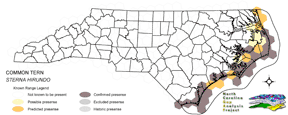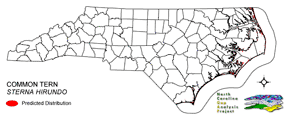
| Taxa: |
| Order: |
| Family: |
| Aves |
| Charadriiformes |
| Laridae |
| NatureServe Global Rank: |
| NatureServe State (NC) Rank: |
| G5 |
| S4B,SZN |
| Federal Status: |
| NC State Status: |
| --- |
| --- |


| Land Unit |
| US Fish & Wildlife Service |
| US Forest Service |
| US National Park Service |
| US Department of Defense |
| NC State Parks |
| NC University System |
| NC Wildlife Res. Com. |
| NC Forest Service |
| NC Div. of Coastal Mgmt. |
| Local Governments |
| Non-Governmental Org. |
| Other Public Lands |
| Private Lands |
| GAP Status 1-2 |
| All Protected Lands |
| Statewide |
| Hectares |
| 13,705.74 |
| 139.14 |
| 6,308.10 |
| 9,548.55 |
| 1,700.64 |
| 0.00 |
| 3,671.01 |
| 0.00 |
| 1,593.81 |
| 2.52 |
| 1,680.39 |
| 34.65 |
| 58,627.71 |
| 26,801.19 |
| 37,903.77 |
| 97,012.26 |
| Acres |
| 33,867.61 |
| 343.82 |
| 15,587.65 |
| 23,594.98 |
| 4,202.37 |
| 0.00 |
| 9,071.26 |
| 0.00 |
| 3,938.39 |
| 6.23 |
| 4,152.33 |
| 85.62 |
| 144,872.20 |
| 66,227.17 |
| 93,662.24 |
| 239,722.47 |
| % of Dist. on |
| Prot. Lands |
| 36.2 % |
| 0.4 % |
| 15.4 % |
| 25.2 % |
| 4.5 % |
| 0.0 % |
| 9.7 % |
| 0.0 % |
| 4.2 % |
| 4.4 % |
| 4.4 % |
| < 0.1 % |
| < 0.1 % |
| 70.7 % |
| ----- |
| ----- |
| % of Dist. on |
| All Lands |
| 14.1 % |
| 0.1 % |
| 6.5 % |
| 9.8 % |
| 1.8 % |
| 0.0 % |
| 3.8 % |
| 0.0 % |
| 1.6 % |
| < 0.1 % |
| 1.7 % |
| < 0.1 % |
| 60.4 % |
| 27.6 % |
| ----- |
| ----- |
|
Common along the coast and on the barrier islands (Portnoy et al. 1988). Nests in large colonies on ocean and sound-side beaches, and in salt marshes (Portnoy et al. 1988). Prefers grassy areas and areas with sparse, matted vegetation. Forages primarily by diving for fish. (Ehrlich et al. 1988). Lays eggs on bare sand or builds nest on the sand or in shells and detritis left by tide (Ehrlich et al. 1988). NATURE SERVE GLOBAL HABITAT COMMENTS: Seacoasts, estuaries, bays, lakes, rivers, and marshes. Nests on sandy, pebbly, or stony beaches, matted vegetation, marsh islands, and grassy areas; typically on isolated, sparsely vegetated islands in large lakes or along coast, also in rivers. Breeds successfully on human-made islands, including navigational aids or cribs (Karwowski et al. 1995). See Spendelow and Patton (1988) and Ramos and del Nevo (1995) for further details on nesting habitat in different regions. |
| Code | Name | Description | NC Natural Heritage Program Equivalent |
| 378 | Ocean Beaches | Open beach sand. | Upper Beach |
| 3 | Tidal Marsh | Fresh and brackish tidal marshes, including cord grass, wild rice, sawgrass and needlerush alliances. | Brackish Marsh, Interdune pond, Maritime wet grassland |
| 375 | Hypersaline coastal salt flats | Tidal flats within salt marshes, including saltmeadow cordgrass or sea-purslane dominated alliances. | Salt Marsh |
| 372 | Interdune Herbaceous Wetlands | Dune swales with permanently flooded to intermittently exposed hydrology. Species composition depends on salinity and can include cut grass, spike-rush, mosquito fern, and hornwort. | Interdune Pond, Maritime Wet Grasslands |
| 371 | Maritime Grasslands | Dune grass community consisting of sea oats and beach grasses. | Dune grass, Maritime dry grassland |
| 8 | Open water | Open water without aquatic vegetation. | No equivalent |
|
Erwin, R. M. 1980. Breeding habitat used by colonially nesting waterbirds in two mid-Atlantic US regions under different regimes of human disturbance. Biol. Conserv. 18:39-51.
Alberico, J. A. R., J. M. Reed, and L. W. Oring. 1991. Nesting near a common tern colony increases and decreases spotted sandpiper nest predation. Auk 108:904-910. Howes, L.-A., and W. A. Montevecchi. 1993. Population trends and interactions among terns and gulls in Gros Morne National Park, Newfoundland. Can. J. Zool. 71:1516-1520. Karwowski, K., J. E. Gates, and L. H. Harper. 1995. Common terns nesting on navigational aids and natural islands in the St. Lawrence River, New York. Wilson Bulletin 107:423-436. Zink, R. M., S. Rohwer, A. V. Andreev, and D. L. Dittman. 1995. Trans-Beringia comparisons of mitochondrial DNA differentiation in birds. Condor 97:639-649. Bent, A.C. 1921. Life histories of North American gulls and terns. U.S. Natl. Mux. Bull. 113. Washington, D.C. Palmer, R. S. 1941. A behavior study of the common tern. Proc. Boston Soc. Nat. Hist. 42. 119 pp. Burger, J., and M. Gochfeld. 1991. The common tern:its breeding biology and social behavior. Columbia Univ. Press, New York. 413 pp. Ehrlich, P.R., D.S. Dobkin, and D. Wheye. 1992. Birds in jeopardy:the imperiled and extinct birds of the United States and Canada, including Hawaii and Puerto Rico. Stanford University Press, Stanford, California. 259 pp. Evers, D. C. 1992. A guide to Michigan's endangered wildlife. Univ. Michigan Press, Ann Arbor. viii + 103 pp. Hyslop, C., and J. Kennedy, editors. 1992. Bird trends:a report on results of national ornithological surveys in Canada. Number 2, Autumn 1992. Migratory Birds Conservation Division, Canadian Wildlife Service, Ottawa, Ontario. 20 pp. Morris, R. D., and G. P. Burness. 1992. A new procedure for transmitter attachment:effects on brood attendance and chick feeding rates by male common terns. Condor 94:239-243. Ramos, J. A., and A. J. del Nevo. 1995. Nest-site selection by roseate terns and common terns in the Azores. Auk 112:580-589. Safina, C., and J. Burger. 1988. Prey dynamics and the breeding phenology of common terns (STERNA HIRUNDO). Auk 105:720-726. Safina, C., et al. 1988. Evidence for prey limitation of common and roseate tern reproduction. Condor 90:852-859. Burns, K. J., and R. M. Zink. 1990. Temporal and geographic homogeneity of gene frequencies in the fox sparrow (PASSERELLA ILIACA). Auk 107:421-425. Nisbet, I. C. T. 1983. Paralytic shellfish poisoning:effects on breeding terns. Condor 85:338-345. Barrett, R. T., and W. Vader. 1990. The status and conservation of breeding seabirds in Norway. Pages 323-333 in Croxall et al., eds. Status and conservation of the world's seabirds. ICBP Tech. Pub. No. 2. Barcena, F., A. M. Teixeira, and Andres Bermejo. 1984. Breeding seabird populations in the Atlantic sector of the Iberian Peninsula. Pages 335-345 in Croxall et al., eds. Status and conservation of the world's seabirds. ICBP Tech. Pub. No. 2. Brown, R. G. B., and D. N. Nettleship. 1984. The seabirds of northeastern North America:their present status and conservation requirements. Pages 85-100 in Croxall et al., eds. Status and conservation of the world's seabirds. ICBP Tech. Pub. No. 2. Buckley, P. A., and F. G. Buckley. 1984. Seabirds of the north and middle Atlantic coast of the United States:their status and conservation. Pages 101-133 in Croxall et al., eds. Status and conservation of the world's seabirds. ICBP Tech. Pub. No. 2. Clapp, R. B., and P. A. Buckley. 1984. Status and conservation of seabirds in the southeastern United States. Pages 135-155 in Croxall et al., eds. Status and conservation of the world's seabirds. ICBP Tech. Pub. No. 2. Cooper, J., A. J. Williams, and P. L. Britton. 1984. Distribution, population sizes and conservation of breeding seabirds in the Afrotropical region. Pages 403-419 in Croxall et al., eds. Status and conservation of the world's seabirds. ICBP Tech. Pub. No Evans, P. G. H. 1984. Status and conservation of seabirds in northwest Europe (excluding Norways and the USSR). Pages 293-321 in Croxall et al., eds. Status and conservation of the world's seabirds. ICBP Tech. Pub. No. 2. Hays, H. 1984. Common terns raise young from successive broods. Auk 101:274-280. James, P. C. 1984. The status and conservation of seabirds in the Mediterranean region. Pages 371-375 in Croxall et al., eds. Status and conservation of the world's seabirds. ICBP Tech. Pub. No. 2. Le Grand, G., K. Emmerson, and A. Martin. 1984. The status and conservation of seabirds in the Macaronesian Islands. Pages 377-391 in Croxall et al., eds. Status and conservation of the world's seabirds. ICBP Tech. Pub. No. 2. Melville, D. S. 1984. Seabirds of China and the surrounding seas. Pages 501-511 in Croxall et al., eds. Status and conservation of the world's seabirds. ICBP Tech. Pub. No. 2. Nisbet, I. C. T., and M. J. Welton. 1984. Seasonal variations in breeding success of common terns:consequencesof predation. Condor 86:53-60. Harrison, C. 1978. A field guide to the nests, eggs and nestlings of North American birds. Collins, Cleveland, Ohio. Harrison, H.H. 1979. A field guide to western birds' nests. Houghton Mifflin Company, Boston. 279 pp. van Halewyn, R., and R. L. Norton. 1984. The status and conservation of seabirds in the Caribbean. Pages 169-222 in Croxall et al., eds. Status and conservation of the world's seabirds. ICBP Tech. Pub. No. 2. Wiggins, D. A., et al. 1984. Occurrence and timing of second clutches in common terns. Auk 101:281-284. Terres, J.K. 1980. The Audubon Society encyclopedia of North American birds. Alfred A. Knopf, New York. Minsky, D. 1981. The terns of Cape Cod. The Associaiton for the Preservation of Cape Cod, Informational Bull. No. 9. 34 pp. American Ornithologists' Union (AOU), Committee on Classification and Nomenclature. 1983. Check-list of North American Birds. Sixth Edition. American Ornithologists' Union, Allen Press, Inc., Lawrence, Kansas. Raffaele, H.A. 1983. A guide to the birds of Puerto Rico and the Virgin Islands. Fondo Educativo Interamericano, San Juan, Puerto Rico. 255 pp. Ehrlich, P.R., D.S. Dobkin, and D. Wheye. 1988. The birder's handbook:a field guide to the natural history of North American birds. Simon and Shuster, Inc., New York. xxx + 785 pp. Spendelow, J.A., and S.R. Patton. 1988. National atlas of coastal waterbird colonies in the contiguous United States:1976-1982. U.S. Fish and Wildlife Service, Biological Report 88(5). x + 326 pp. Stiles, F.G., and A.F. Skutch. 1989. A guide to the birds of Costa Rica. Comstock Publ. Associates, Cornell University Press, Ithaca, New York. 511 pp. Chapdelaine, G., and P. Brousseau. 1992. Distribution, abundance, and changes of seabird populations of the Gaspe Peninsula, Quebec, 1979-1989. Can. field-Nat. 106:427-434. |
For more information please contact them at:
NC-GAP Analysis Project
Dept. of Zoology, NCSU
Campus Box 7617
Raleigh, NC 27695-7617
(919) 513-2853
www.basic.ncsu.edu/ncgap